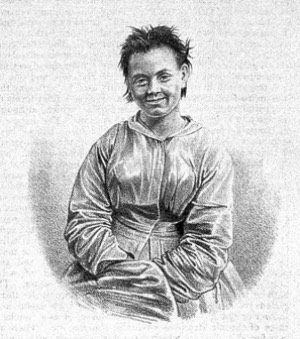
 Puerperal mania in four stages, Medical times, 1858, Wellcome collection.
Puerperal mania in four stages, Medical times, 1858, Wellcome collection.
Since antiquity medicine has described forms of delirium associated with childbirth and caused by the retention of milk in the breasts. The definition of “puerperal madness“ originated from the texts of obstetrics of the late eighteenth century. One of the goals is to distinguish it, somehow, from other puerperal diseases, such as puerperal fever spreading at this time in maternity homes. At first, it was not considered a true diagnosis. The doctors simply observed the occurrence of delusions after childbirth, hence the name that follows: the insanity of lactation (during pregnancy, childbirth, or lactation). It can manifest as manic or melancholic. Esquirol studied it at La Salpêtrière (« Observations sur l'aliénation mentale à la suite de couches », Journal général de médecine, de chirurgie et de pharmacie, 1818) and reported one of his nine clinical cases: “22 April 1814. Childbirth, convulsions for 24 hours. April 23: cessation of convulsions, delirium, continuous laughter. April 24: general delirium, agitation, fury, refusal to take food but irresistible desire to drink fresh water. During the night, exasperation. The milk does not arrive in the breasts“.
The diagnosis of “puerperal insanity“ is gradually admitted in medical nosology even if no real specificities are recognized, except one — time-related — of puerperium and perhaps its extravagances. Since the idea that milk retention has an impact on the brain has been abandoned, it has been difficult to determine a specific etiology. The alienists also question the relevance to keep such a little specific diagnosis, that could be linked to both mania and melancholy. Despite this scientific weakness, the diagnosis of puerperal insanity survives and adapts to changes in classification. At the end of the 19th century, the definition of “puerperal psychoses“ prevailed over the word “insanity“, considered as outdated. Gilbert Ballet, one of Charcot’s students, consecrated in 1895 his work to the division of the entity into several species: “Let me tell you from the outset, that this expression of puerperal insanity seems to be defective. It seems to indicate that there is a pathological entity, always identical to itself by its causes and symptomatology. I hope to show you that this is not the case; and the mental disorders that occur during puerperium are very different from each other by their pathogenesis, their nature, their physiognomy, and their evolution. This amounts to saying that there is not one puerperal insanity, but plural, or better, puerperal psychosis.”
Today, French child psychiatry, in particular, uses the terminology “perinatal depressions“ and distinguishes three forms of the disease: puerperal psychosis, post-partum depression, and baby blues. But, from an international perspective, psychiatry has not found a consensus on these diagnoses. Some currents of psychiatry, that weigh on the evolution of classifications, still question the relevance of separating these pathologies from the largest clinical pictures of depression and psychosis and if to consider puerperal follies as specific diseases?
Behind these scientific debates is a fundamental questioning of the naturalness of motherhood. If we consider motherhood as a time at risk of insanity, do we presuppose an essential difference between the sexes? It is indeed the only mental disorder still existing today that would strike only one sex if we exclude, perhaps, the “premenstrual dysphoric disorder“ — although contested by part of psychiatry — that found a new development in the Diagnostic and Statistical Manual of Mental Disorders, the DSM-5. Even though medicine strives to explore paternal mental disorders and to reshape the nosology of parenting disorders, it does not succeed to get away from an ancient biological representation. Thus, maternity becomes, even more than before, a bio-psychic function of women. One question remains: what about paternity?
Read more in the dictionary : Criminal abortion - Caesarian section
Read the paper in French : Folie puerpérale
Références :
Hilary Marland, Dangerous Motherhood: Insanity and Childbirth in Victorian Britain Houndmills, Palgrave-Macmillan, 2004.
Francesca Arena, Trouble dans la maternité. Pour une histoire des folies puerpérales (XVIIIe-XXe siècles), PUP Aix-en-Provence, Collection « Penser le genre », dirigée par Randi Deguilhem et Laurence Hérault, sous presse, février 2020, 208 p.
To quote this paper : Francesca Arena, "Puerperal Insanity", in Hervé Guillemain (ed.), DicoPolHiS, Le Mans Université, 2022.